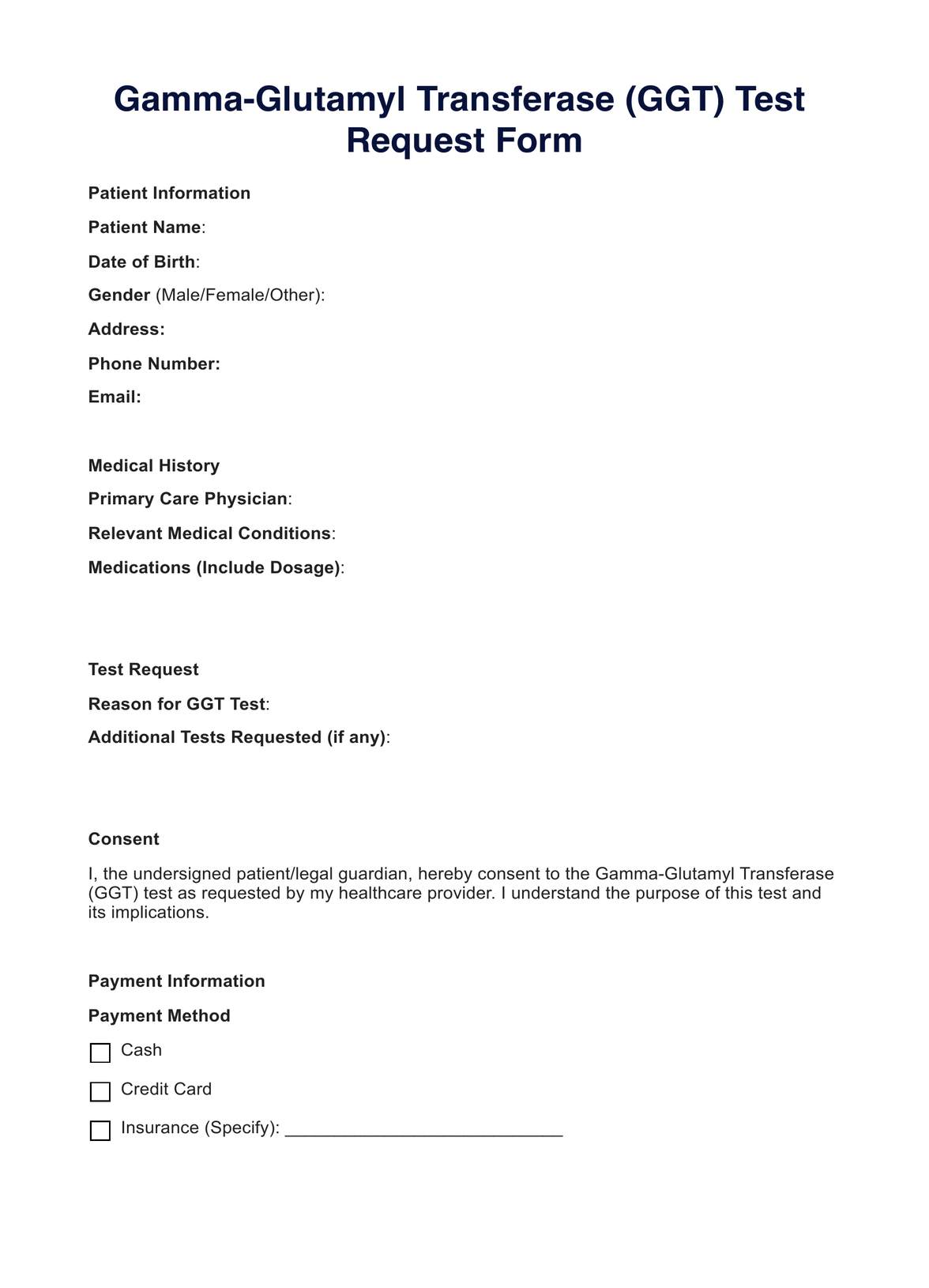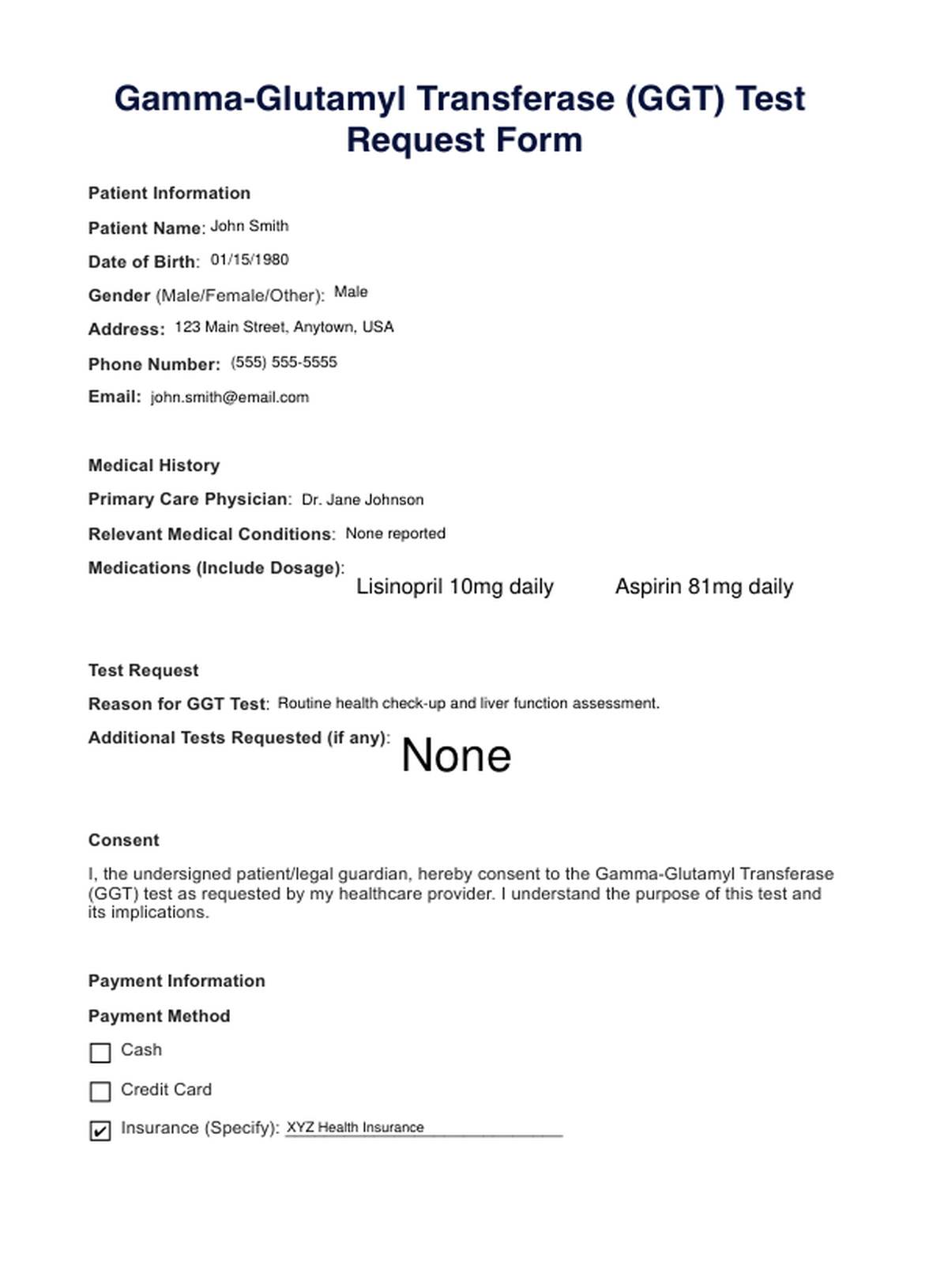Gamma-Glutamyl Transferase
Request, track, and manage Gamma-Glutamyl Transferase tests with our comprehensive form. Ensure efficient patient care. Download the PDF now.


What is a Gamma-Glutamyl Transferase (GGT) Test?
A Gamma-Glutamyl Transferase (GGT) test is a diagnostic blood test that measures the levels of the enzyme gamma-glutamyl transferase in the bloodstream. GGT is primarily found in the liver and other tissues, such as the kidneys, pancreas, and spleen. The test is a valuable tool in assessing liver and biliary system function and can provide crucial information for diagnosing and monitoring various medical conditions.
The GGT test is typically ordered as part of a liver function panel, along with other liver enzymes like alanine aminotransferase (ALT) and aspartate aminotransferase (AST). Elevations in GGT levels can indicate liver damage or disease, particularly when combined with abnormal levels of other liver enzymes. High GGT levels may be associated with conditions such as:
- Liver disease: GGT is sensitive to liver damage caused by alcohol, hepatitis, or other liver diseases.
- Biliary tract issues: Elevated GGT can be a sign of blocked bile ducts, which may result from gallstones, tumors, or other obstructions.
- Excessive alcohol consumption: Chronic alcohol use can lead to elevated GGT levels, making this test helpful in assessing alcohol-related liver damage.
A GGT test is also used to monitor the progress of certain liver conditions and evaluate treatments' effectiveness.
GGT levels should be interpreted in conjunction with clinical symptoms and other diagnostic tests, as elevated GGT levels alone do not pinpoint a specific disease. It's essential to consult with a healthcare provider who can use the GGT test results in the context of your medical history and overall health.
Gamma-Glutamyl Transferase Template
Gamma-Glutamyl Transferase Example
How Does it Work?
Sample Collection
The procedure starts with a healthcare professional drawing a blood sample from a vein in the patient's arm.
Blood Separation
After collection, the blood sample is spun in a centrifuge to separate the serum from the blood cells. This serum contains the enzymes, including GGT, to be measured.
Laboratory Analysis
The separated serum is subjected to specialized laboratory analysis. The GGT test involves using dedicated equipment and reagents to determine the enzyme's levels.
Form Retrieval
Simultaneously, the printable Gamma-Glutamyl Transferase Test form is obtained, often from the healthcare provider, laboratory, or online medical resources.
Form Completion
- Patient Information: Essential personal details like name, date of birth, and contact information are provided.
- Medical History: Pertinent medical history, including any pre-existing liver conditions or medications, is documented.
- Test Request: The reason for the GGT test is specified, along with any additional tests.
- Consent: The form may necessitate the patient's or legal guardian's signature to consent to the test.
- Payment: If required, the payment method or insurance details are added.
- Laboratory Information: Details about the laboratory where the test will be conducted and any specific instructions are included.
- Signature: The form is signed by a healthcare provider or the patient, per local regulations.
Submission
The fully completed form is submitted to the designated laboratory for testing.
Results Interpretation
Following laboratory analysis, a healthcare provider reviews the GGT test results in the context of the patient's medical history, symptoms, and other diagnostic tests to draw appropriate conclusions.
When Would you use this Test?
The Gamma-Glutamyl Transferase (GGT) test, also known as the Gamma-GT or GGTP test, is a valuable tool for healthcare practitioners in various medical specialties. Its primary purpose is to assess liver and biliary system function, making it useful in a range of clinical scenarios:
- Liver Disease Diagnosis: GGT is particularly important in diagnosing liver diseases, such as hepatitis, cirrhosis, or fatty liver disease. Elevated GGT levels, when accompanied by other liver function tests, can indicate the presence and severity of these conditions.
- Alcohol-Related Liver Damage: GGT is sensitive to alcohol-induced liver damage, making it a key parameter in evaluating the impact of excessive alcohol consumption.
- Routine Health Screenings: GGT may be included in regular health check-ups to monitor overall liver health and identify potential issues early, especially in individuals with risk factors like obesity, alcohol consumption, or certain medications.
- Acute Liver Injury: In emergency settings, the GGT test can be employed to assess and monitor acute liver injury, such as in cases of drug overdose or alcohol poisoning.
- Pregnancy-Related Conditions: Elevated GGT levels may be associated with conditions like intrahepatic cholestasis of pregnancy, and monitoring GGT can help assess and manage such situations.
- Kidney Function: GGT is also found in the kidneys; abnormal levels might indicate kidney disease.
- Biliary Tract Cancer: GGT can be a marker for biliary tract issues, including cancer, and is used with other diagnostic tests to identify and monitor such conditions.
- Autoimmune Liver Disease: Certain autoimmune conditions, such as primary biliary cirrhosis, can affect GGT levels, making the test relevant for rheumatologists.
- Substance Use Monitoring: In addiction medicine, GGT is used to assess the impact of substance abuse on liver function and to encourage patients to address potential health concerns.
What do the Results Mean?
Interpreting the results of a Gamma-Glutamyl Transferase (GGT) test is essential for understanding the status of liver and biliary system health. GGT levels are reported in units per liter (U/L) and can provide valuable insights into various medical conditions:
Normal Range
The reference range for GGT can vary slightly between laboratories, but a typical range for adults is 9 to 48 U/L for men and 8 to 35 U/L for women. These values represent the expected GGT levels in a healthy individual.
Elevated GGT Levels
Higher than normal GGT levels can have several implications:
- Liver Disease: Mild to moderately elevated GGT levels may suggest liver damage, such as hepatitis or fatty liver disease. It is often used with other liver function tests for a comprehensive assessment.
- Alcohol Consumption: GGT is particularly sensitive to alcohol-induced liver damage. Elevated levels without other liver abnormalities may indicate heavy or chronic alcohol consumption.
- Biliary Tract Issues: GGT can also rise due to problems in the biliary system, including bile duct obstruction or gallstone-related issues.
- Medications: Certain drugs and medicines can cause GGT levels to increase, so it's essential to consider the patient's medication history.
Decreased GGT Levels
While less common, lower than normal GGT levels may be observed and could be indicative of:
- Malnutrition: GGT is a protein, so malnutrition or protein deficiency can reduce GGT levels.
- Genetic Conditions: Rare genetic disorders may lead to lower GGT levels.
It's crucial to understand that GGT results are not specific to any particular condition. Interpretation should always consider the patient's medical history, clinical symptoms, and the context of other liver function tests. Abnormal GGT levels often prompt further diagnostic investigations to identify the underlying cause.
Research & Evidence
The Gamma-Glutamyl Transferase (GGT) test has a history rooted in the study of liver function and enzymology.
The enzyme GGT was first discovered in the mid-20th century. It was initially called "transpeptidase" due to its ability to transfer peptides between amino acids. Later, it was renamed Gamma-Glutamyl Transferase for its specific function in transferring gamma-glutamyl groups.
In the 1960s, researchers recognized the clinical relevance of GGT as a marker for liver and biliary tract function. This led to the development of the GGT test for diagnostic purposes.
Numerous research studies have established a strong association between elevated GGT levels and liver diseases. It has proven a valuable marker for liver damage, including hepatitis, cirrhosis, and non-alcoholic fatty liver disease.
The sensitivity of GGT to alcohol-induced liver damage is well-documented. Several studies have confirmed that GGT levels can rise significantly in individuals with heavy or chronic alcohol consumption.
GGT is also a reliable marker for biliary tract issues. Elevated GGT levels are commonly found in conditions such as bile duct obstruction, cholecystitis (gallbladder inflammation), and gallstones. Extensive research has identified specific medications that can cause GGT elevation, contributing to its clinical utility in monitoring drug-induced liver injury.
Large-scale epidemiological studies have explored the relationship between GGT levels and various health outcomes, including cardiovascular risk factors, metabolic syndrome, and mortality. Elevated GGT has been associated with an increased risk of certain health conditions.
GGT is often included in clinical guidelines for liver function testing. For example, it is part of the commonly used Model for End-Stage Liver Disease (MELD) score in liver transplantation evaluation.
References
- Bergen, T. (2023, May 26). Gamma-Glutamyl transpeptidase (GGT) test. Healthline. https://www.healthline.com/health/gamma-glutamyl-transpeptidase
- Dillon, J., & Miller, M. H. (2016). Gamma glutamyl transferase ??To be or not to be?? a liver function test? Annals of Clinical Biochemistry, 53(6), 629??631. https://doi.org/10.1177/0004563216659887
- Faacc, T. K. P. D. (2022, September 29). GGT Blood Test (Gamma Glutamyl Tranferase/Transpeptidase) - Testing.com. Testing.com. https://www.testing.com/tests/gamma-glutamyl-transferase-ggt/
- Galan, N., RN. (2023, January 11). What to know about the GGT test. https://www.medicalnewstoday.com/articles/325199
- Ghadban, R., MD. (n.d.). Gamma glutamyl transferase: reference range, interpretation, collection and panels. https://emedicine.medscape.com/article/2087891-overview?form=fpf
- Heid, M. (2019, July 3). What is a GGT test? WebMD. https://www.webmd.com/hepatitis/ggt-test
- Whitfield, J. B. (2001). Gamma glutamyl transferase. Critical Reviews in Clinical Laboratory Sciences, 38(4), 263??355. https://doi.org/10.1080/20014091084227
Commonly asked questions
Healthcare providers, including primary care physicians, hepatologists, gastroenterologists, and other specialists, typically request GGT tests.
�?�
GGT tests assess liver and biliary system function, diagnose liver diseases, evaluate alcohol-induced liver damage, and monitor certain medications' effects on the liver.
A blood sample is collected from the patient and then analyzed in a laboratory to measure GGT levels. Healthcare providers interpret results to assess liver health.














































































































